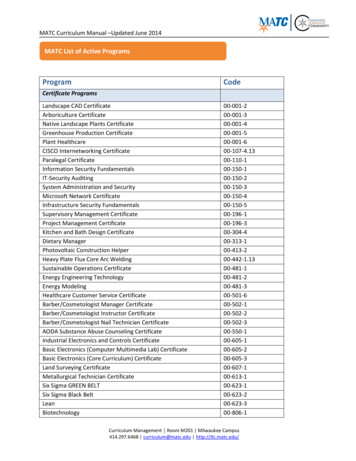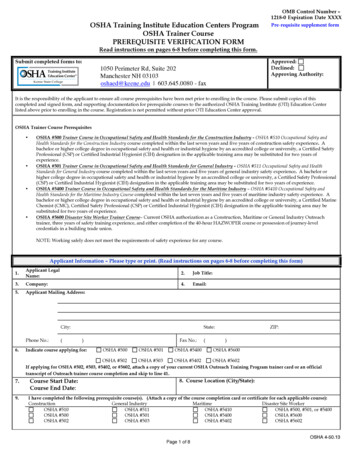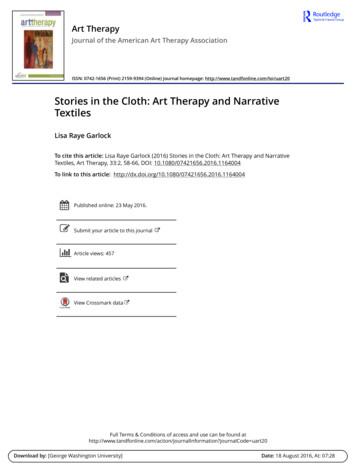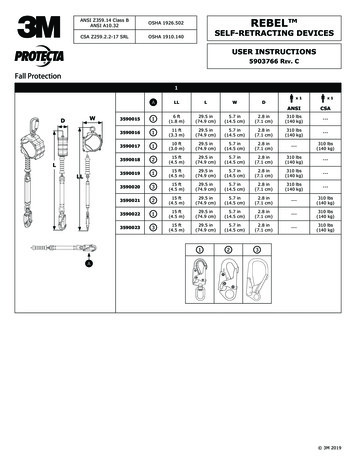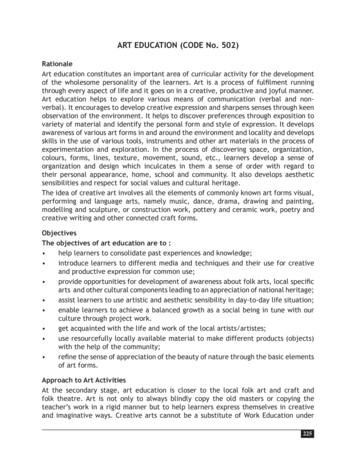
Transcription
ART EDUCATION (CODE No. 502)RationaleArt education constitutes an important area of curricular activity for the developmentof the wholesome personality of the learners. Art is a process of fulfilment runningthrough every aspect of life and it goes on in a creative, productive and joyful manner.Art education helps to explore various means of communication (verbal and nonverbal). It encourages to develop creative expression and sharpens senses through keenobservation of the environment. It helps to discover preferences through exposition tovariety of material and identify the personal form and style of expression. It developsawareness of various art forms in and around the environment and locality and developsskills in the use of various tools, instruments and other art materials in the process ofexperimentation and exploration. In the process of discovering space, organization,colours, forms, lines, texture, movement, sound, etc., learners develop a sense oforganization and design which inculcates in them a sense of order with regard totheir personal appearance, home, school and community. It also develops aestheticsensibilities and respect for social values and cultural heritage.The idea of creative art involves all the elements of commonly known art forms visual,performing and language arts, namely music, dance, drama, drawing and painting,modelling and sculpture, or construction work, pottery and ceramic work, poetry andcreative writing and other connected craft forms.ObjectivesThe objectives of art education are to : help learners to consolidate past experiences and knowledge; introduce learners to different media and techniques and their use for creativeand productive expression for common use; provide opportunities for development of awareness about folk arts, local specificarts and other cultural components leading to an appreciation of national heritage; assist learners to use artistic and aesthetic sensibility in day-to-day life situation; enable learners to achieve a balanced growth as a social being in tune with ourculture through project work. get acquainted with the life and work of the local artists/artistes; use resourcefully locally available material to make different products (objects)with the help of the community; refine the sense of appreciation of the beauty of nature through the basic elementsof art forms.Approach to Art ActivitiesAt the secondary stage, art education is closer to the local folk art and craft andfolk theatre. Art is not only to always blindly copy the old masters or copying theteacher’s work in a rigid manner but to help learners express themselves in creativeand imaginative ways. Creative arts cannot be a substitute of Work Education under225
which a few artistic activities may be conducted but the approach and product wouldbe different.In the interest of the learner, as far as possible, all the media of creative arts may beplaced before them to facilitate selection of one form or a combination of art forms.These are :Visual Arts1. Two-dimensional or PictorialDrawing and PaintingCollage MakingPrintingPhotographyComputer graphics2. Three-dimensionalClay modelling and potteryCarving and sculptureConstructionArt is about creative expression of the learners, uniquely contributed by each one.Studying the works of famous artists of the past or present is undertaken to orient thelearners to varied expressions. Replicating or copying either the Master or the teacher’swork will check the imagination of the students and therefore must be avoided in allcases.Performing and Language Arts Music (Vocal, Instrumental) Movement and Dance Creative Drama and Puppetry Creative Writing and PoetrySources for Art TeachingThe arts programme in schools must reflect the ethos of the region. Artistic expressionin music, poetry, dance theatre and in the creation of forms have been part of humanlife from the very beginning. It is an integral part of human existence. Exposure to thelocal environment and arts must be treated as an essential activity of the school artprogramme.Besides individual expression, the arts provide an opportunity to the learners tostudy and appreciate the contributions made in the past and present. By learning toappreciate music, painting, dance and theatre, students develop aesthetic sensibilityand sensitivity to understand people from other cultures. To build a harmonious society,a productive nation or a world, requires to make learners familiar with the traditionof arts of the local region. The strength and confidence gained from the familiar, willmake it possible for her to respect and appreciate the culture and contribution madeby others.226
A creative expression essentially depends on the approach to create opportunitiesfor learners to explore, imagine and communicate the same in an art form they feelconfident to use. Availability of material and experts closer to the school or communitycan be accented.A. VISUAL ARTSSYLLABUSWhen the school(s) can provide art teachers in different media the following syllabusmay be adopted. Activities in terms of Materials/Media and Techniques.Two-dimensional or Pictorial Activities Study of visual resources and means of creative expression.Study of lines, strokes, colours, shades, tones, textures, etc. while organizingtwo dimensional space with two dimensional and three dimensional shapesand forms.Sketching from nature and surrounding.Creative use of colours to show space, atmosphere, subjective moods.Creative use of perspective in spatial relationship.Study of calligraphic strokes of Devnagari and Roman alphabet (Scripts).Use of contrast as an expressive element of art.Study and use of various media and techniques to the extent of theiravailability.Pencil, charcoal, water colour, crayon, oil colours, poster colour and gouache,acrylic colour and other unconventional sources of colours such as vermillion,yellow and red earth, rice flour, and tools like painting brushes for watercolours and oil colours, Painting surfaces such as papers of various kindsand quality, like smooth, rough, thick, thin, etc., canvas, hardboard, simplemarking cloth pasted on paper, etc.Collage and mosaic work with a variety of coloured papers and colouredprinted pictures/photographs from magazines and newspapers.Printing : Mono printing, Printing with wood-cut blocks, lino-cut and metalfoil : serigraphy (silk screen), self-made stencil, etc.Basic knowledge of computer graphics.Three-dimensional or sculptural activities Study of basic forms in clayStudy of various materials such as clay, plaster of paris, soft-stone, wood(blocks, twigs and branches, roots, etc.), metal scraps, plastic sheets, wirethread, papers and cardboards, vegetables and other throw-away availablematerials.Study of natural and man-made forms, human figures, birds, animals,vegetation and other objects like household items, buildings or as desired bythe students.227
- Objects of day-to-day use in groups and in different settings and arrangements.AssignmentsAssignments in two and three-dimensional subjective forms and utility and functionalart and craft forms in different media and techniques. Painting, murals, graphics, claymodelling, wood-carving, soft-stone, plaster of paris, block of brick constructions,collage mobils, applique, pottery and ceramics, masks, and puppets, textile designing(including tie-dye and batik, and block printing) poster designing, lay-out illustrationsand photography, etc.Correlating Art Activities with Other School Activities Construction of puppets and their costumes and improvised puppet stage ortheatre, correlation with Home Science and Arts (Drama) subjects. Aesthetic organization of the physical environment by enhancing the surroundingarea, i.e., landscaping including plantation of trees and other flowering plantsand vegetables, etc., correlating with Agriculture, Home Science and EnvironmentStudies activities. Constructing stage setting props such as curtain, backdrops, stage lighting,improvised furniture sets, etc., designing utility (crafts) items; correlating withWork Education activities. Designing the school magazine and bulletin boards, making posters for schoolfunctions, and greeting/invitation cards, stage scenes for music, dance, dramaperformances, etc., correlating with applied Art activities.Note: These activities and other group activities may emerge in project form atindividual levels also.Group Activities Organization, display and exhibitions of students’ periodical and sessional work. Organizing inter school art exhibitions to widen their interaction and horizon. Planning and organizing festivals and celebrations of the community, culturalevenings, musical concerts, film shows and other performances including regionaland folk (traditional art forms). Participating in study visits to museums, botanical gardens, zoological garden, artgalleries and art institutions, etc., for greater awareness of the environment andcultural variations.Theoretical Understanding of Art and Culture Short notes on important aspects of Indian art and culture based on Social Science.Such writing may be based on reproduction of art work printed in Textbooks. Contribution made by any one contemporary artist. Knowledge of terms : Contour, texture, graphic, form, volume, space, tone,printmaking, collage, amateur, modelling in relief, mobil construction, applique,calligraphy, layout, poster and composition.228
B. Performing ArtsMusic (Vocal) TheoryKnowledge of the terms: Sangeet, Nad, Swar, Shudh, Komal, Teevra, Saptak,Mandra, Madhya Tar, Aroha Avaroha, Raga, Laya, Matra, Tal, Avartan, SamTal.Basics knowledge of notation systems.A brief introduction of Indian music Practical ActivitiesNational AnthemSongs for community singinga) Five folk or tribal songs of different regions, indicating time of the year, occasionand the function with which they related. Writing down the same with its meaningand knowledge of its rhythm.b) Five devotional songs (Bhajans, Shlokas, Hymns, Sufiana Kalam and Shabad Kirtan)c)Three songs in regional languages other than mother tongue.d) Three patriotic songs on the theme of universal love and amity.To create proper sense of swara and laya through Talabadh and Alankaras.Introduction to the structure of any four of the following Ragas with : Bilawal, Yaman,Kafi, Bhairav, Shankarabharan, Kalyani, Mayamalav gaud, Todi (accompaniment ofTanpura and Tabla or Mrudang). The Teacher should communicate the characteristicfeatures of the raga and its swaras pattern. The teacher may use references of popularsongs for Raga association.The following tals and their thekas-Kaharva, Dadra, Trital, Jhaptal & Aditala, AlankarTalas.Project Work To collect photographs of great musicians, with a write-up on their introduction,and all types of musical instruments (photographs/illustrations) and the artistswho play them. (To be pasted in the scrap-book). To listen to music programme on Radio or T.V. and to write short description of theperformances (To be written in the scrap-book).Music (Melodic Instrument) TheoryKnowledge of the terms : Sangeet, Dhwani, Nad, Swar (Shudha, Komal,Teevra) Saptak (Mandra, Madhya, Tar) Aroha, Avaroha, Raga, Gat, Laya Matra,Tal, Avartan, Sam Tal, Khali, Laghu Dhrutham, Anu Dhrutham.Basic Knowledge of notation systems.Short notes on at least four musical instruments, their main components andthe characteristics of the sound (music) they produce.229
Practical ActivitiesTuning and playing of any one of the following instruments: Sitar, Sarod,Violin, Flute, Veena, Mandolin, Guitar (accompaniment of Tabla).The candidates playing musical instruments may be allowed to opt for communitysinging or for instrumental assemble based either on the ragas from the syllabusor light and folk dhun (Melodies).To create proper sense of swaras and layas through Talabadh Alankaras.The following ragas with descriptive details : Bilawal, Yaman, Kafi, Bhairav,Sharkarbharanam, Kalyani, Mayamalav gaud, Todi, Saveri (accompaniment ofTanpura and Tabla).The following five talas and their thekas : Kaharva, Dadra, Trital, Jhaptal, Adi Tala,Alankar TalaCreative DramaThis is the stage at which young people are to be introduced to theatre and related craftsto broaden their understanding of drama through literature. Their previous experienceof creative drama will help in exploring the area as under: TheoryKnowledge of the terms: Mime, play script, movement, characterization,stage, stage props, stage costumes, stage movements, stage lighting, oneact play, etc. Practical ActivitiesWarming-up freeing activity in rhythmic movement and pantomime.Exercises in characterization.Exercises in speech dialogue delivery.Exercises in creation of plot and conflict based on: (i) episodes and happeningsin day-to-day life situations: (ii) episodes from stories from textbooks orstory books; (iii) short scenes from classical dramas.Stage Craft : Planning a stage with props and lighting placement, movementof character of a given play in drawing form or model form.designing of costumes for the characters of the play.Play-writing: unscripted play to be written down in the form of a script to beacted.Note : Formal performance before an audience can be an incentive to good workat this stage.Dance & MovementMovement and rhythm, as expressed through dance, have long been the heart andsoul of all cultures. Dance allows people to discover, explore and develop their naturalinstincts for movement, enabling students of dance to develop not only their motorskills but also their mental and emotional personalities. The purpose of this course isto enhance the appreciation and understanding of the different forms of dance andmovement as practiced across cultures today, with specific reference to Indian context.230
i.TheoryDance as a form of nonverbal communication, exhibited through Gymnastics,figure skating, synchronized swimming and martial arts as well.ii. Reasons for people to move and Dance: (include visual references)a. for personal expression and social connection,b. as a medium for sensing, understanding, and communicating ideas, feelings,and experiences,c.a means to mourn, to celebrate, to heal, to give thanks,d. to preserve cultural heritage and treasured legends,e. demonstrate physical prowess, to assert individuality, to provoke and toentertain.iii. Forms of movement and dance :a. Formal, exhibitionistic dance with trained dancers (Classical traditions)b. Reflections of or challenge to the social, cultural, religious traditions andvalues (Folk or semi-classical or dance drama formats)c.Various forms now seen in a theatrical context that have their roots in ancienttemple dances (Ritualistic or festive dancing)d. Entertainment (Cinematic/social)iv. Definitions of dance through social, cultural, aesthetic, artistic and moral contexts.(participatory, social, performed for an audience, ceremonial, competitive orerotic, classical, folk or experimental)v.Dance as a means of communication: elements of dance (content, vocabulary,skills and technique)vi. Brief history of the evolution of dance (Indian/Western, Mythology/history, regionaldifferences, major exponents)PracticalIntroduction to the elements of costume, music form, instruments, distinguishingfeatures, region and language of the following:i.Major styles of classical dance - Bharatnatyam, Kathakali, Kuchipudi, Kathak,Mohiniattam, Manipuri, Odissi, chhau and Sattriya.ii. Tribal and folk dances of India: region-wise samples (need not to be exhaustive)iii. Modern experimental dance (Indian and Western)iv. Western styles: Ballet, Jazz, Salsa, Street, FunkThe teacher must use as much visual material in the form of videos, pictures, slideshows etc as possible to impart the training.Assignments:i.Creation of a scrap book that documents the different dance stylesii. Chart tabulation of music, costume, region, language associationiii. Identification of dance styles/exponents in quiz formativ. Writing creative pieces (prose/poetry/drama) on dance231
Correlating Dance Activities with other school subjectsUnderstanding dance and its elements helps develop cultural sensitivity in students(Values Education)Appreciation of the traditional forms of dance and movement enhance the capacity ofpreserving heritage (Heritage and Culture)Delving into Dance history helps understand the period and context of society relatedto the art form (Social Sciences)Hints for the Teachers Students should be encouraged to work individually as well as in small groups, girlsand boys working together. Learners should be encouraged to enquire about the technique, procedures andthe work of master artists/artistes.333 Students should be encouraged and helped in handling new media and tools andmeeting the new challenges in various problem-solving situations encountered bythem Students should be encouraged to take the initiative and to critically evaluatetheir work. Since the adolescents are prone to adult influence, adult activities and methodsworking, she starts imitating and idealizing the adult approach and attitude to herwork. The teacher, at this stage should try to make the adolescent child aware ofthe originality and uniqueness of her own work and encourage her to develop herown methods and style of working as there exists a large variety and divergence inadults’ work. The teacher should develop friendly and empathetic relations with the studentsand should encourage them to know about the artistic activities of the localcommunity. The teacher should organize studio/art room/theatre/stage with the help ofstudents. The teacher should organize visits of museums, historical places, exhibitions,botanical and zoological gardens, theatre and local drama activities, music anddance concerts, film shows, etc. The teacher should help children in the planning and organization of display andexhibitions, musical and other performances of master artists/artistes. The teacher should develop projects correlating art activities with other subjectswith the cooperation of other subject teachers. The teacher should encourage the use of improvised instruments and tools by thestudents locally available. The teaching approach should be inductive and students should be encouraged tomobilize their own resources to solve their problems. Direct instructions in thetechniques should be avoided. They should be encouraged to develop techniquesand styles of their own through exploration of discovery of materials, media, toolsand techniques.232
story books; (iii) short scenes from classical dramas. - Stage Craft : Planning a stage with props and lighting placement, movement of character of a given play in drawing form or model form

